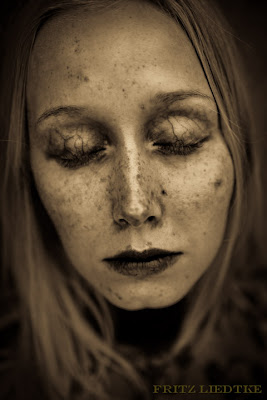Fritz Liedtke
Looking at participants from Photolucida…
At Thursday night’s portfolio walk at the Portland Art Museum, one body of work literally had a glow (and a crowd). Portland photographer, Fritz Liedtke’s new project, Astra Velum, was absolutely stunning in person. I featured one of Fritz’s earlier projects, Skeleton in the Closet on LENSCRATCH last year, and with this project, he takes a whole new approach.
Beauty is only skin deep. But ah! me; freckles go to the bone. ~Mark Twain
Statement for Astra Velum:April, a freckled woman whom I photographed for this series, told me a story from her childhood. One day after playing outside, her grandmother asked her to go wash up. She went to the bathroom and did so, but grandma wasn’t satisfied. “Your face isn’t clean! Go scrub it some more!” The young girl was distraught, for all that was left on her skin were her freckles, and no amount of scrubbing would make them go away.
While many people view freckles as an aberration or blemish, my response is the opposite. I find them enchanting, unique, even exotic. More than once, while photographing for this series, a model thanked me for making something beautiful out of what they often viewed as a flaw.
This series is hand-printed by the artist as a limited edition set of photogravures. I’ve used photogravure for this series for several reasons.
First, in the digital age, I feel more and more distant from the handmade quality of photography—the manual labor of developing film and dodging and burning prints. But even darkroom work—which I never particularly enjoyed in and of itself—created a product that was made by hand, but showed no evidence of it. For this reason I’m drawn to processes like tintype, encaustic, and photogravure, which show clear evidence of the artist’s involvement with the final product.
Until now, I’ve not been a process person; I’d rather shoot and edit, and then have a print magically appear (which, of course, is the draw of inkjet printing). But I’ve found a real pleasure in the process of printing photogravure. While it’s the most complicated printing process I’ve ever pursued, it does have its advantages. I enjoy the craftiness of it—cutting out handmade paper for the chin-collé, inking and wiping the plate just so, the steady rhythm of turning the crank on the press, pulling the print off the plate and catching my breath, stunned by its beauty. I like the rounded corners of the plate, the indentation of the plate in the paper, the traces of unwiped ink at its edges, the occasional fingerprint. Like freckles, these are not flaws, but beauty marks.
Photogravure also offers a final product imitated but not reproduced by any other photographic printing medium: chin-collé. This method of impressing a second paper in between the ink and the backing paper is a traditional technique in printmaking. It consists of cutting a piece of paper—in my case, a handmade Japanese paper—the exact same size as the plate. When inked, the plate is placed on the press bed with the Japanese paper over top, and on top of that paper a glue is applied. Finally, the backing paper is placed in register over the plate and Japanese paper. This stack is run through the press, which exerts approximately 45,000 pounds of pressure on the sandwich of plate and papers. In doing so, the ink is pressed into the Japanese paper, which is glued and embossed into the backing paper. In this way, I create a unique print, with glowing warm high values (from the warm Japanese paper), placed against the white of the backing paper. The result is a hand-made print whose depth and luminescence is unmatched by any other pho tographic print-making process. They really must be seen in person to be fully appreciated.
I’m also drawn to the tactile nature of a photogravure. The papers used are often handmade, with a texture meant to be felt with your fingertips. The ink embedded in the paper also gives texture to the image itself. For these reasons, handmade photogravures seemed the perfect medium for a series which, at its essence, explores the beauty of surface textures: human skin and its freckles and scars, like a thin veil of stars.
Posts on Lenscratch may not be reproduced without the permission of the Lenscratch staff and the photographer.
Recommended
-
Earth Month Photographers on Photographers: Tyler Green in Conversation with Megan JacobsApril 15th, 2024
-
Luther Price: New Utopia and Light Fracture Presented by VSW PressApril 7th, 2024
-
Emilio Rojas: On Gloria Anzaldúa’s Borderlands: The New MestizaMarch 30th, 2024
-
Artists of Türkiye: Cansu YildiranMarch 29th, 2024
-
Artists of Türkiye: Sirkhane DarkroomMarch 26th, 2024










































































